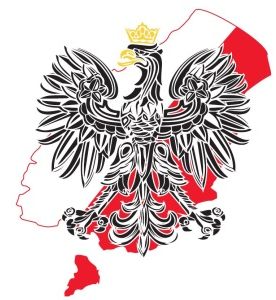Polish Settlers at Germantown and the Gore District
“In passing through Mr. McNabs run at Mataura the other day, we were again struck with the very excellent nature of the land on this run for the opening up of which on the deferred payments system so many are now waiting, and many parties, we learned are now visiting the spot of anticipation of some day owning a free hold there. The working plans of the Mataura to Clutha line are now being prepared by Mr. Aitken and his survey party of eight assistants in all, and it is expected that here long tenders will be called for the construction of this portion of the Southern line. “Bruce Herald, 19 December 1873
“A large number of parties from the Taieri passed through Milton the other day to pay a visit to the blocks of land to be opened on the deferred system of payments on McNabs run, Mataura, with the view of making selections. “Bruce Herald, 17 April 1874
“A number of the parties who went from the Taieri to examine the blocks to be opened on McNab’s run, Mataura, yesterday, under the system of deferred payments have returned thoroughly disgusted. They corroborate the opinion of our Mataura correspondent in his letter published in our issue of the 27th March, as to the character of the blocks being the most inferior that could have been selected on that gentleman’s run. Notwithstanding, such being the case, they seem to think, that it may be all applied for as they were assured by Mr Calder that he must have crossed at the Mataura at least from 300 t0 350 persons on their way to examine the blocks, such appears to be the anxiety of people to obtain land to settle upon. We hope that our informants will carry out their proposal to wait as a special deputation upon his Honor and give him the results of their own personal investigations. Would the Secretary of Lands publish the report of some reliable official as to the quality of the blocks selected on M’Nab’s run as compared to the rest of the run, as was, done in the case of the land at Miller’s Flat? We throw down the challenge.” Bruce Herald, 21 April 1874, p 5
On the 6th of May, 1874, at the Invercargill Land Office, the New Zealand Government threw open for selection the first part of McNab’s Knapdale Run from the Gordon (now East Gore) Boundary through to Whiterig, Knapdale and Otama including both properties on both sides of the Pinnacle Road and over to Waikaka Siding (now McNab) and up past Howe Siding.
“Work was commenced on the railway line from Gore, Mataura to Clinton on McMinanini’s contract a month ago, and 40 men are now employed at the Mataura end. Should sufficient labour be obtainable, the contractor hopes to finish the work within eighteen months. “Bruce Herald, 20 November 1874
A majority of Polish immigrants, from the ship’s Palmerston, Reichstag, Sussex, and Scimitar, found work on the various sections along the Southern Trunk line. As the railway work on the Taieri drew near to completion, families who remained in the area found work on neighbouring farms or acquired small pockets of land for themselves. The rest followed the railway construction south, first settling around Waipahi and finally establishing a settlement just north of Gore. Here construction proceeded between Gore and Clinton attracting a new wave of people to the district.
Hugh Smith, an old timer from Gore, in his recollections recalls:
“During the years 1875-76-77 the railway was being built from Gore eastwards towards Clinton. One man had the contract for this whole section to Clinton, but he seemed to let the work out in sub-contracts of a mile or so. Therefore, one could see tents here and there along the route. For the portion of line between Gore and Pukerau most of the men seemed to live mostly at Gore or Germantown.” “Many of the workers,” Mr. Smith recalled, “were Germans or Poles, and their speech and ways were so different from ours that it afforded great scope for district discussion. If you went near the line you could hear them jabbering in their own language…”
“The application for deferred payment sections on McNabs run at Mataura are numerous, as the land is of good quality. “Bruce Herald, 12 February 1875
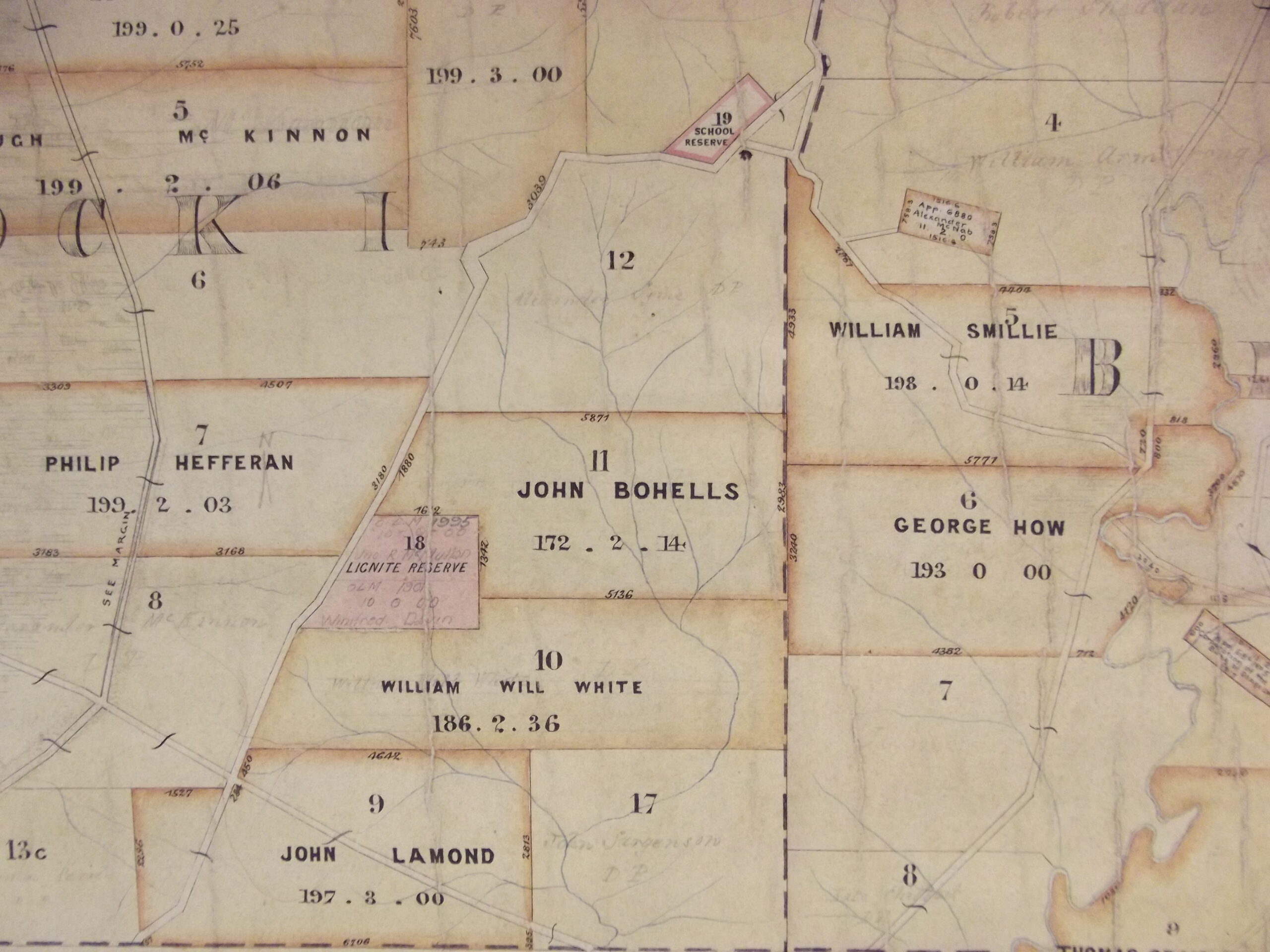
Part of Crown Grant Map, Waikaka Survey District, Block One, Courtesy of “Archives New Zealand Te Rua Mahara O Te Kawanatanga,”
Mid 1874, Johann Bucholz (via “Palmerston”) was successful in the ballot for a 200-acre section of land to the north east of Gore, drawing third section on the McNab run, from the East Gore boundary on the highway known as Symes and Pinnacle Road. He was later joined by a considerable number of his fellow countrymen in search of a place where they might pitch their tents and having heard that there was likely to be a school built up on the Pinnacle, about one and a-half miles away. They decided to camp upon the coal reserve along John Bucholz’s farm, the part that was not taken up on account of it being non-coal-bearing. Bucholz divided his property for purchase on the 28th of February 1878 to settlers; August Regefske having 40 acres, Michael Leitze and Wilhelm Voight having 33 acres, John Dovalofske having 22 acres. Shortly later John Dovalofske sold half of his 22 acres to John Klucofske. The next thing was to have these subdivisions surveyed and sent to the Land Board. These were accepted and transfer being completed. Thus, was the birth of “Germantown” aptly named due to the language widely spoken, but concealing the true nature of its’ inhabitants.
For the most part, the sections contained 200 acres (more or less) and were open for selection by settlers under the deferred payment system at an upset value of 25s an acre. The conditions under which the land was offered were, that the applicant must; along with his application, forward half a year’s rent in advance. The capital value of the section and the interest thereon were computed so that, provided the conditions were complied with and the rent paid regularly, the land would become the property of the settler at the end of 10 years, but there was also another clause which stipulated that the settler must be living on the property within six months of allotment and must continue to do so for the first three years. At the end of that term the settler could, if he wished, buy the land from the Government and freehold it. The compulsory residential part of this clause was to keep out the land grabber or the speculator.
After being successful at the ballot the settler must first make provision for accommodation for himself and family. If he were a bachelor a hut was generally sufficient, but in the case of married men a two or three-roomed cottage was necessary. Some brought their families with them and lived in tents while a house was being erected; others left their families behind until they had accommodation ready for them. In many cases it was a sod house of two to four rooms that was erected, and, if well built and thatched with either snow grass tussock or rushes, these made very comfortable abodes – warm in winter and cool in summer. As glass was precious, windows were kept to a minimum and there generally being only one door to reduce any draught. There was much contentment and happiness among the people living in these conditions. Some of these houses were in use for quite a few years, and one built by August Regefske was occupied for over 20 years and was then still in good order.
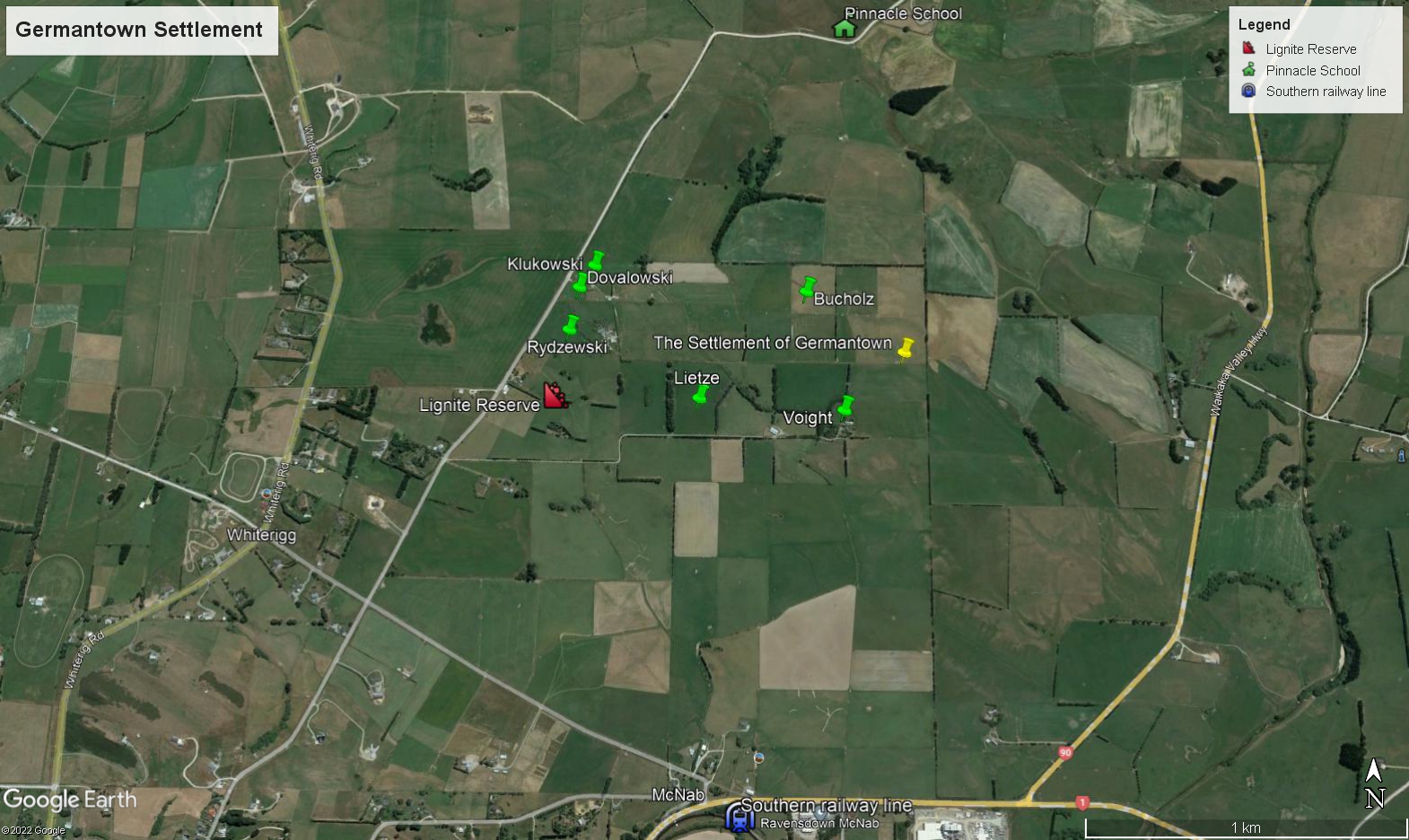
Location of Germantown and it’s residents, courtesy of Google Earth
Having ensured that the family was well settled in their new home, the settler must next attend to the erection of a boundary fence between his own holding and that of his neighbour, and usually they came to a mutual understanding about what form this would take. In most cases this took the form of a sod fence, especially by those whose finance was limited, as the settler could do the work with the assistance of his family. These fences, well constructed, and reaching five feet were not only sound but also provided shelter for stock and would last for years. Some of the settlers sent away for young gorse plants to put in at the bottom of these sod fences; others bought the seed, which was obtainable in stores at 3s, a pound. The new farmers thought that if they could only get a live fence round their place they would be “Set”. They certainly had no idea of the legacy they were leaving for those who came after them.
John Halfka and John Hoffman soon settled each building himself a house on Bucholz’s place. Along from the coal reserve John Regefske built one for himself on his father’s property in the same area. John Klucofske settled and where there were a lot of big trees was Michael Lietze, so that brought the number up to 10 families living in the section taken up originally by Bucholz. Others who also camped on this reserve were Joseph Belisky, John Zicosky, Albert Kenisky, and Joseph Stepansky. They did not live there all at the same time. Some came and others went. It is estimated that between 20 and 30 families lived in this small settlement during its brief period of existence.
The coal reserve contained some 40 acres, and it was open to the general public to apply to the Land Board for a prospecting license. If successful in locating a seam deemed to be profitable to work the prospector could peg off two acres, which was the maximum for one man. The rental for each claim taken up was one pound a year.
John Hoffman had one such pit. John Hoffman, Michael Leitze and August Gutchlag delivered coal into Gore and also sold it to settlers who came to the pit. The coal delivered into Gore was charged from 8s to 12s a load, which represented about a ton. While working their claims at the coal reserve, the first generation of Hoffman’s also did some shearing, and Johann was also successful as a road contractor. While carrying out the latter job, they formed and gravelled the road from the Pinnacle Road crossroad to the front of Mr. A Middlemass’ property in Gore.
The small township at Longford (Gore), a distance of 5km south of the Waikaka Valley provided for the communities needs. The township consisted of a hotel, a police camp, a hut and a small store close to the railway bridge then in course of construction. One settler recalls crossing the partially made bridge on a plank, and a ticklish job he thought it. Arrived at Brennan’s Hotel he had the opportunity of seeing the Gore Post Office in operation, and like everything else in those days it was somewhat primitive. Mr. Ned Brennan was the Postmaster, and he took the slender mailbag and simply poured its contents out on a table and let the settlers pick their own.
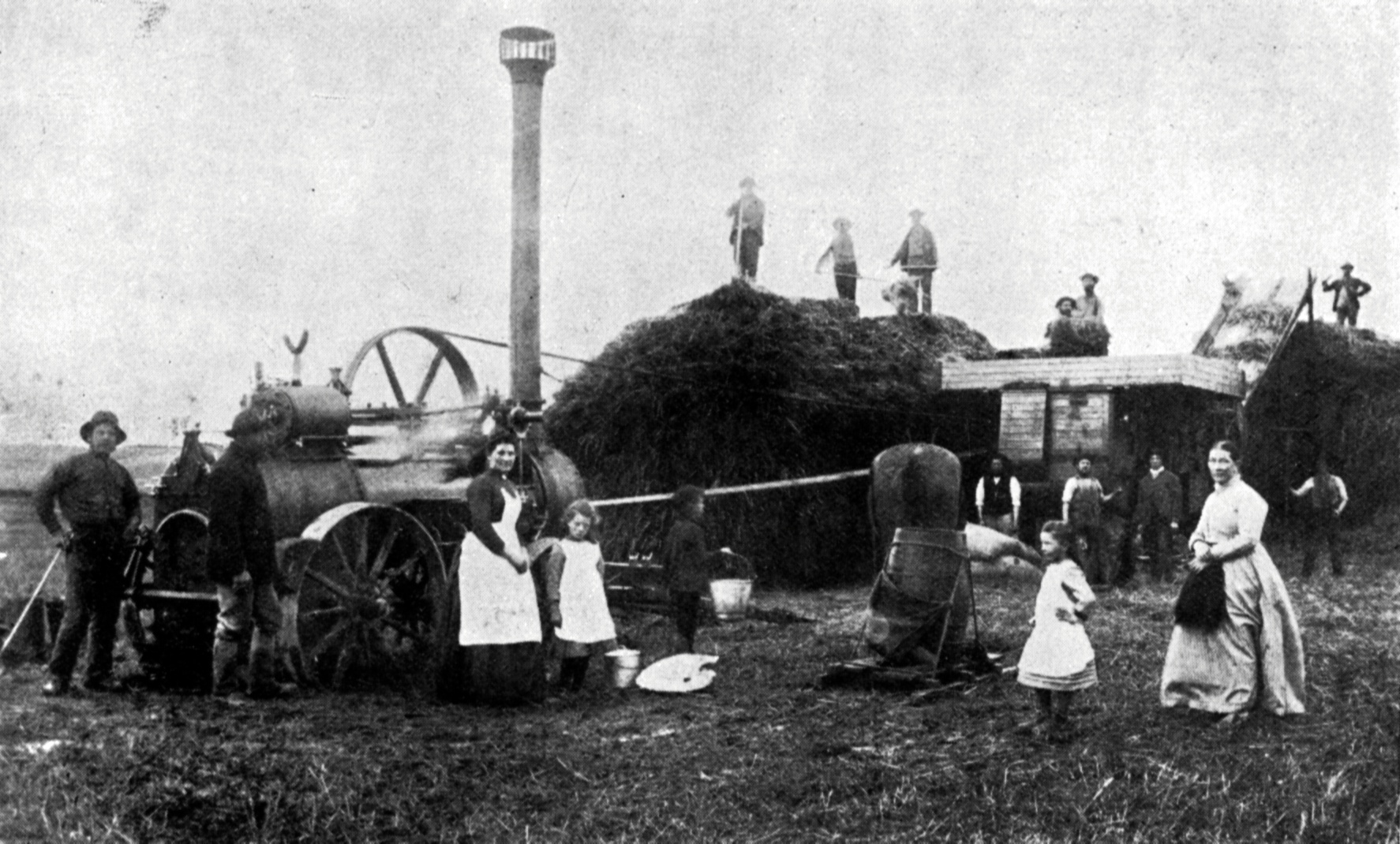
Harvest time in the Waikaka Valley, where families from all around the area would pitch in
As a source of labour, harvest time provided a great boon to the settlers in the surrounding district, when many hands were required to tie the grain after it was cut by the back delivery. It was quite a common thing to see young girls or women handling their quota alongside the men; in fact, they were better than some of the men, as they would not put out a sheaf unless it was well tied.
Obviously, there was a need for a place of education for the young generation so on the 19th of April 1877, the first public school was opened by Mr. Field (first teacher in the area). The school was built on a site at the corner of Section 1A, Block I, Waikaka Survey District, and it was called the Pinnacle School, the name having been suggested no doubt by the commanding view from the site. The opening of the East Gore School in June 1886, no doubt affected the attendance at the Pinnacle School. Owing to the extension of settlement and the need of schools elsewhere, the Pinnacle School was closed on September the 10th 1886. The school and residence were shifted in sections on sledges to Waikaka Valley and reopened there on December the 1st, 1886, with an attendance of 17.
Pinnacle School
(Early Polish children)
Joseph Beleski, Joseph Buchols, Ann Develoski, John Develoski, Mary Develosk, Kate Halfka, August Hoffman, Joe Halfka, John Hoffman, Joseph Hoffman, Mary Hoffman, John Klukovski and Frances Regeski.
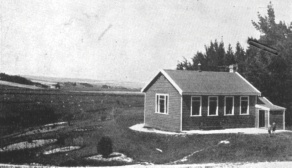
Waikaka School
Waikaka Valley School
(Early Polish children)
Agnes Halfka, Annie Halfka, John Halfka Kate Halfka, Martha Halfka and Nellie Halfka.
RECOLLECTIONS;
“In the Gore Police Court on Friday John Devoloskie was charged with having on January 22 at Waikaka threatened to shoot John Bucholz. Dr Macaffer JP and Mr. Souness JP occupied the Bench; and Messrs Aldridge and Henderson appeared for the complainant and the defendant respectively. John Halfke deposed that he had heard Devoloskie say that he would shoot Bucholz; that he tried two caps, which did not go off, but that the third would be all right. The threat was repeated and was accompanied by violent behaviour. In answer to Mr. Henderson, witness made a rambling statement about a ghost with a long tail, which seemed to have been the cause of the trouble; but it was Bucholz that was to be shot, not the ghost. According to other evidence, Devoloskie had said a ghost was always coming to his house causing a disturbance among his sheep and frightening his wife; that he had tried to shoot the ghost, which had a long tail, and in all respects this one resembled Bucholz, whom he had tried to shoot. The gun, however, did not go off, but if it did go off, he would shoot him. He was sober. Bucholz lost his wife recently. To Mr. Henderson, witness could not really say whether Devoloskie really intended to shoot Bucholz. The complainant gave evidence and was cross-examined by Mr. Henderson, his evidence disclosing little of importance or interest beyond the fact that the morality of some of the Germans residing at Waikaka could be questioned. Without considering it necessary to hear evidence for the defence, the Bench dismissed the case.“ Mataura Ensign, January 1883
“One family had a large family of mainly boys, who were contractors and who got into difficulties with their creditors. The creditors put a private bailiff in charge of all stock, implements and the house. The boys worked out a scheme to get rid of the bailiff, and a distress warrant, by filling the said bailiff with beer, which must have been doped, because it put him into a deep sleep in a small outhouse. While he was asleep, they hitched up the horses and carried the house and everything intact – cattle, horses, and implements – onto a section inside the town boundary, a mile from the poor bailiff. When he woke up the next morning, sitting in the outhouse, lord of all her surveyed, which was the coal reserve minus all fittings. The reaction of the bailiff’s employer would have made interesting reading. The law did not allow a distress warrant to be followed onto other property.” Darcy Hoffman, Hoffman, p 23
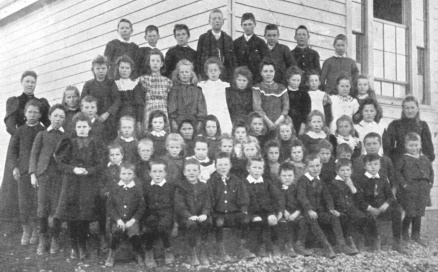
Early Waikaka School pupils.
“Another tale concerns one the German Town settlers who married a woman much too young for him and who never found married bliss. He became so mental that his wife told him to drown himself. The unfortunate man tried to oblige, but chose to sit on the gavel beach of the Mataura River for most of the day, waiting for the tide to come in! Mr. Whytock, who lived on the opposite side of the river, notified Sergeant Fleming of the Gore police. Sergeant Fleming and the official Court bailiff drove over to the timber bridge to Gordon (East Gore) and up to where the man was sitting with his pockets filled with stones. The Sergeant asked him what he was doing there, and the unfortunate man replied that his wife had told him to go and drown himself, and he was sitting there waiting for the tide to come in and carry him away. The Sergeant, who was a son of old Ireland, replied in an amusing way: “Well, me fine boy, ye will wait a long time there for the tide to come in. We will take ye to a place where the tide will come in much faster”. So, they took him to a doctor named Copeland, who certified him as insane and sent him to Seacliff Mental Hospital, where he spent the rest of his life, until the final time came in and took him away from a living death.” Darcey Hoffman, Hoffman, p 23
“There was mention of the “Lady of the Lake” in the town of Gordon (East Gore) where there were no hotels in that district, and those who were game made their own liquid refreshments. However, once you began to sell your product that was sly grogging. One of those was a Polish woman who had lost her husband and had several boys who decided to supplement their income with the sale of beer. From the reports, they made a very good brew. The mother was not very well educated and one day the police called and asked her if she had any beer. She said yes, and gave them a glass. They asked her if they could buy some. She was shrewd enough to say that was all she had, and they said they would come back. They did call, and she told the boys to take the kegs to bed with them. There was no beer to be found in the house. The Mataura River had flooded at one time and left a lake at the bottom of the street. That was where the beer was kept nice and cool, and that is how the Polish lady got the name of Lady of the Lake.” Darcey Hoffman, Hoffman, p 24
“Knapdale Road Board. The monthly meeting was held at Chatton on Friday. Present — Messrs McQueen (chairman), Peter, Syme, Kennedy, Key, Turnbull, Cruickshank, Nichol and Gilchrist. ‘committees’ reports. The Otama committee reported that Messrs G. McLeod, Gerkin, and; P. Mallon were allowing gorse to spread on the roads. The Waikaka committee reported on the Pinnacle road and the road McKinnon’s to Waikaka Siding. They found that the setters had complied, with the order of the Board, with the exception of Mr Hoffman. They recommended that he be given the statutory notice, and that Messrs: Dryden, Regesky and Bucholz be reminded that there were a few plants on the roads opposite their properties. It was further mentioned that there was a deal of gorse on the road opposite the Coal Reserve on the Pinnacle load, which no one seemed to be responsible for. The Clerk was instructed to serve the usual notices. THE COAL RESERVE. Mr Syme said he knew two settlers who had already paid close on L4O for the lease of coal pits on the reserve, and the Land Board could well afford to clear the gorse which was spreading all over the reserve. The gorse on the road could then be dealt with. If the reserve were leased the tenant might clear the gorse. He moved that the Clerk write the Land Board in regard to the gorse, and mention that a considerable amount of money had been received by that body from the Coal Reserve. — Seconded by Mr Kennedy, and carried.” Mataura Ensign, 01 November 1892, p 5

B: John Franz Rydzewski, Paulina Anna Johnston (nee Rydzewska), Thomas Reginald Johnston, August Valentin Rydzewski, Franciszka Rydzewski or Josephine Rydzewski (nee Szczepanska) – with bike. F: James Paul Schultz, Rosalia Marianna Rydzewski (nee Sliwinska), Alexander Andrew Schultz, Marianna Rosalia Schultz (nee Rydzewska) and Thomas Andrew Schultz at Rydzewski cottage, East Gore, 1896. Original held by Maria Hurrell and courtesy of kiwiwizard1 who originally shared this on 08 August 2019 on ancestry.com
The first known Mass celebrated in the district was at the house, (a sod hut on Middle Road, some 800m from Whiterig) of Mr. and Mrs. Philip Heffernan. Mrs. Heffernan invited the few Catholics to their humble cottage when Father Larkins celebrated this mass some time in the mid 1870’s. Less than a decade later, on the 28th of December 1882, Bishop Patrick Moran established the “Mission of Gore” parish. A year on saw the opening celebrations for the Church of the Blessed Sacrament on the 14th of October 1883.
Over the last century, the Parish community, like the many tributaries that form the mighty Mataura, grew from the streamlets of Maori, German, Hungarian, Polish, Irish, Scottish, English and Dutch settlers, to create a river of diversity and lasting legacy.
Germantown had its incidents, its characters and its moments of glory, but as a settlement it was short lived. After the completion of the Clinton-Gore railway line, some went on to farms of their own and others followed railway construction work on the Waimea line, Waipahi-Tapanui line or the Gore-Lumsden line. Gradually as the railway employment declined, the settlers moved on and took up other jobs or acquired land for themselves.
Today little remains of the quaint colony, which existed at least until the turn of the century. With the exception of a few Polish names almost unrecognisable, they were noted for their thrift, discipline, and application to hard work. They maintained religious affiliations, and lived at Germantown quite happily and unmolested until they were ready to shift to greener pastures.
“PUBLIC NOTICES. IMPOUNDED. Impounded at Gore Pound on December 4. 1914—Three Yearling Steers (2 red and white steers and 1 red heifer); taken from Pinnacle Road. Germantown. No visible brands. If not claimed and expenses paid, the above will be sold on December 18, 1914. M. RICHARDS. Pound keeper.” Mataura Ensign, 5 December 1914, p 1
“GERMANTOWN. Gore Celebrations. A Matter of Nationality. To more correctly understand the position it has to be explained that there is an unusually large percentage of residents in and about Gore who are natives of Germany, or are of German parentage. The major portion of these have originated from some ten families who previously resided between McKnab and Whiterig (close to Gore), or what is still known as Germantown. Most of these families and their descendants have moved into East Gore, and there must now be quite 100 adults either natives of Germany or of German parentage residing there. It is interesting to note that many of these people were prior to the war proud of the fact that they were subjects of the Kaiser, but have subsequently denied their allegiance to that much-hated monarch, and wished it be understood that they were “Poles.” It is true that there are people residing in and about Gore who were born in Poland. but these have always been recognised as Poles. The older generation of Germans are looked upon as highly respectable people. and are recognised as good citizens; but the same, unfortunately, cannot be said of many of the younger generation, who make no secret of the fact that their sympathies lie on the side of Germany in the present life-and-death struggle. Among this generation there is a larrikin element, whose actions, to say the least of it, are not conducive to a unanimous patriotic feeling. It must not be forgotten either that four of the young men who took part in the now notorious “celebrations” are of German parentage, and their cognomens make this very apparent. The actions of these young men may have been perfectly innocent, but the fact that the “celebrations” synchronised with the somewhat dispiriting news then to hand about the North Sea engagement lent credence to the supposition that the participants were paying their tribute to German prowess, and if their actions have been wrongly interpreted they have only themselves to blame.” Evening Star, 12 June 1916, p 4
Names of Polish settlers at Germantown and in the Gore area include; Bielicki (Belesky), Bucholc (Buchols), Dovalowski (Dovalosky), Haftka (Halfka), Hoffman, Klukowski (Klucofske), Rydzewski (Regefske), Szczepański (Stepansky), Szulca (Schultz), Tykowski (Tekofskie) and Zykowski (Zicosky).
Resources;
Hoffman Darcey, Dunedin, Hoffman, A brief history, (1991), pp 22, 23 & 24.
Compiled by Paul Klemick (2022)
